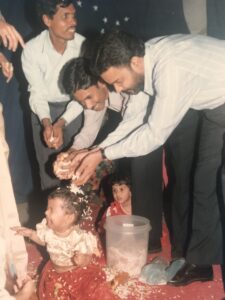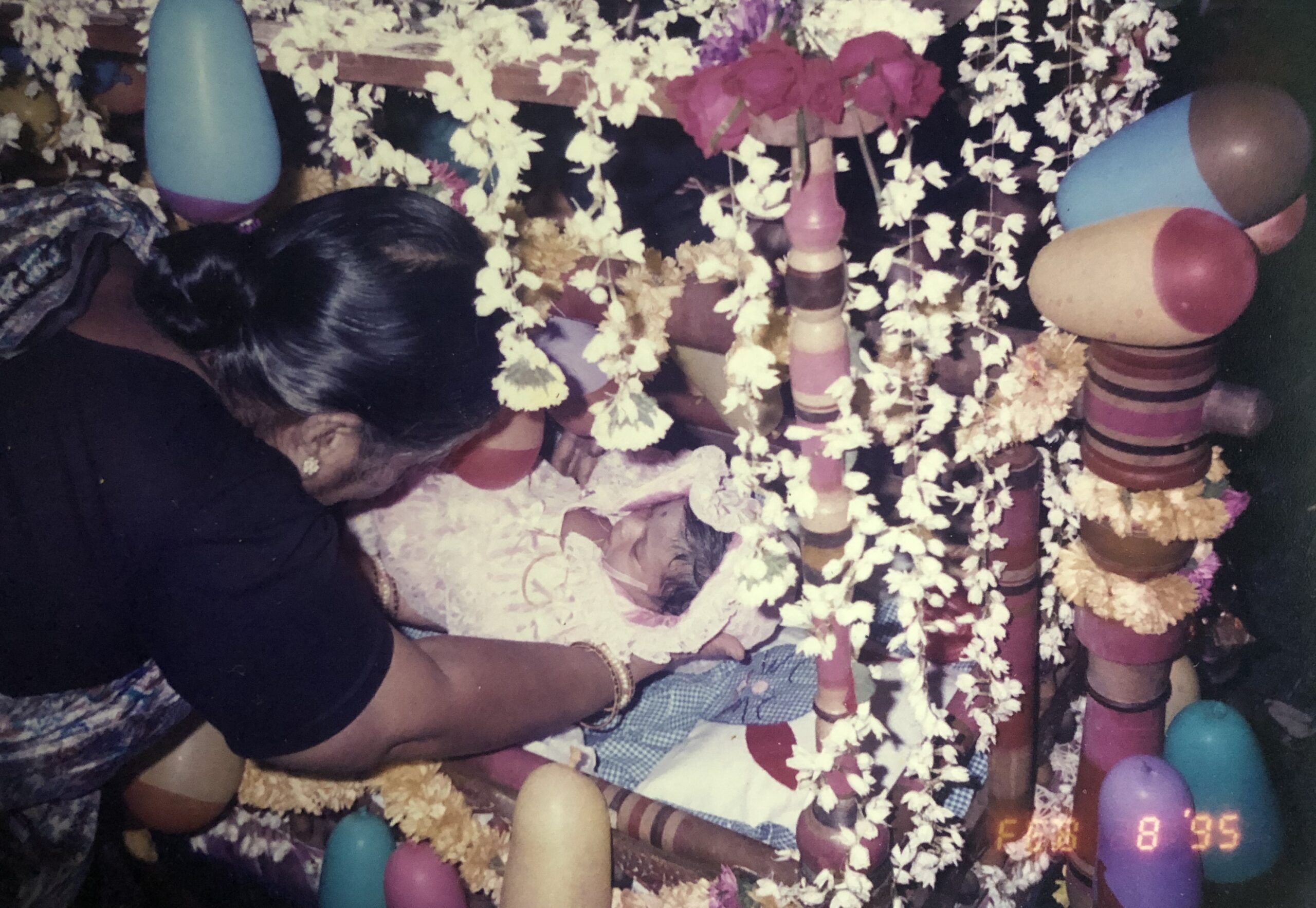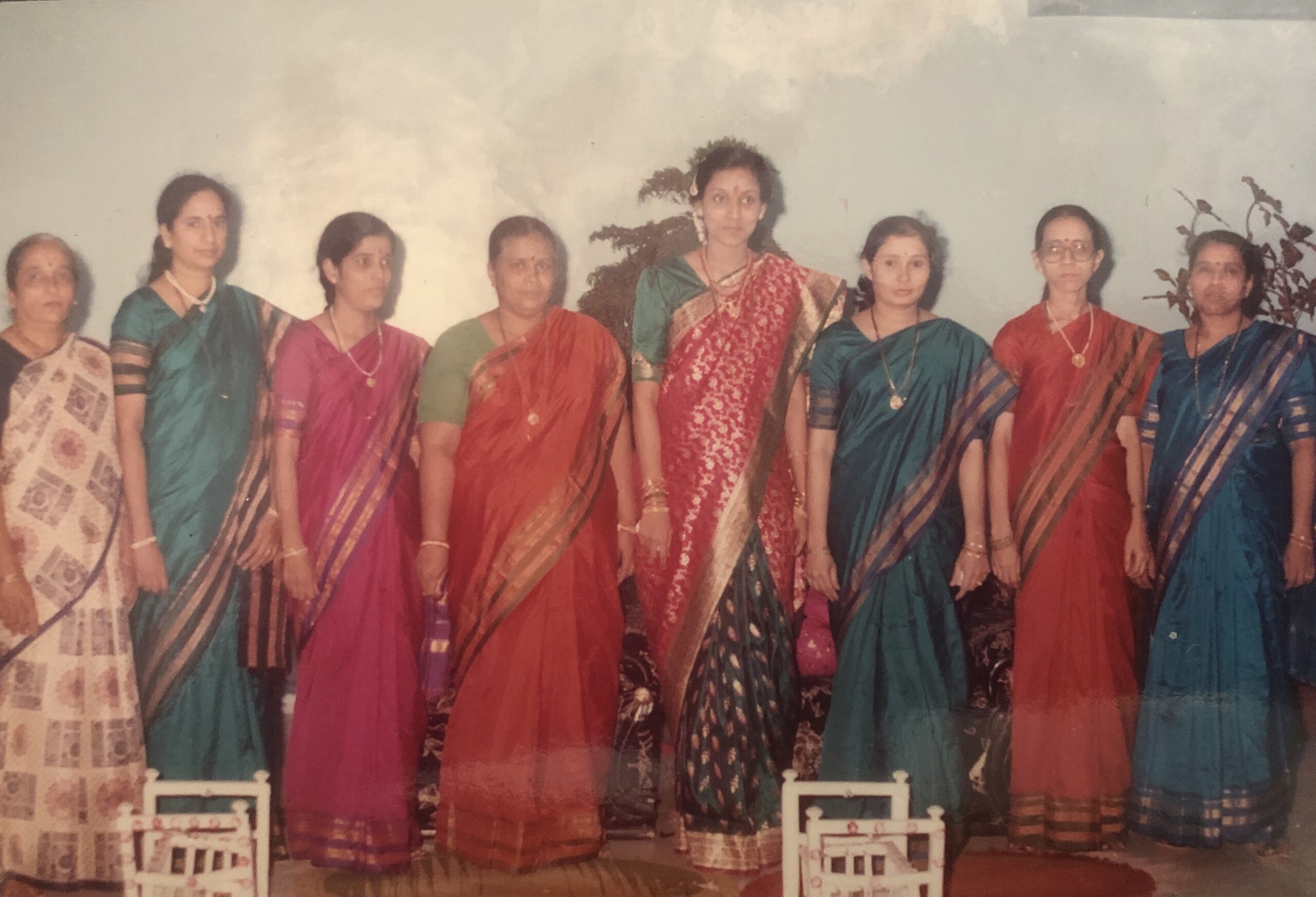A life cycle of rituals typically begins at the indication of pregnancy and continues through childhood. My Grandmother, Meera Kamat’s family albums are rich archives of such rites; the announcement of birth, naming the newborn, and other ceremonies recorded through three generations.

Rimmi’s 9-month baby shower.
Persons featured- (L-R) Rimmi, Meera, Aniket Kamar(child)
The baby shower (fula) is marked by a gathering of women from both sides of the family, to pray for good health and wellbeing of the mother, and bless her unborn child. The fula has three rituals, the first at 5 months of pregnancy (paach mhaynyachi fula), the second at 7 months (saat mhaynyachi fula) and the last in the 9th month (nau mhaynyachi fula).

Rimmi’s ‘nau mhaynyachi fula’.
Persons featured- Rimmi

Rimmi with her aunts at her ‘nau mhaynyachi fula’
Persons featured- (L-R) Pratibha, Kiran, Nisha, Jayamala, Rimmi, Bharati, Tanuja, Nivedita.
Meera reminisces “Our time was different. I don’t recollect hiring a photographer for these ceremonies when I was expecting Rimmi, my daughter; but I made sure to document her baby shower ceremonies when she was expecting her daughter.” The first two fulas are at the paternal home, while the last one is at the maternal home, where the mother rests after she gives birth. The expecting mother is pampered, offered gifts of flowers and delicious treats like faral (sweets made from milk, shaped like fruits, birds, and animals). Meera says “Our culture is so rich. Every ritual or ceremony has its own importance with relation to life and life stages, from announcing the birth to announcing the death; each stage is defined in the scriptures and traditions so beautifully.”

Rimmi’s ‘paachvi fula’, with her mother in law.
Persons featured- (L-R) Rimmi and Jayamala
For instance, “paachvi fula” has a theme of the colour Green (Paachvo rang in Konkani), representing fertility and growth.
Upon arrival, the baby’s naming ceremony “baarso” takes place on the 12th day. 12 in Konkani is “bara”, the etymological root of baarso. The baby is placed in a decorated cradle, then passed between the paternal and maternal grandmothers from beneath the cradle, symbolizing the bond created between their families. The mother in turn is blessed for the happiness and life she brings. The baby’s paternal aunt (attya) whispers the chosen name into the child’s ear.
Meera Kamat recalls the naming ceremonies of her daughter and three sons. “we had already named our daughter Mahima and then we named her a second time with the name suggested by my sister (maushi), derived from their Punjabi neighbor’s daughter’s name; back in Delhi where they were based at that time. We named her Rimmi. She had one name each from her paternal and maternal aunts.”
Rituals continue as the child grows. The celebration marking appearance of the first milk-tooth, is called “Datolyo” (Daat in Konkani means tooth), usually performed when the child turns one. Family traditions and beliefs associated with this ceremony are passed through generations. “I dressed my twins, Satyesh ,sarvesh, like lord Krishna, with flower garlands and crowns, on their birthday. They sat on the wooden sitting(patth) and were showered with puffed rice (chirmulyo), mixed with other sweets and chocolates by the family and friends; celebrating the arrival of their ‘first tooth’’, describes Meera.
One such belief relates to the placement of the first tooth. Appearance on the lower dental arch is auspicious; but if the first tooth appears on the upper dental arch, one must perform amends to fix the undesirable omen. The maternal uncle offers his blood and a red cloth to the child, before seeing the tooth for the first time.

Date-1996
Studio-Sadguru Photo Studio, Curchorem
Subject- Meerat’s grandaughter’s datolyo II
Persons featured- (L-R) Manasri Pai Dukle, Abhay Kamat, Sushant Kamat, Sarvesh Kamat.

Date-1996
Studio-Sadguru Photo Studio, Curchorem
Subject- Meera’s grandaughter’s datolyo
Persons featured-Manashri Pai Dukle (child in the center), others not known.
“One of my twins had his first tooth growing on the upper jaw side and my brother had to turn the’ inauspicious to auspicious’ by gifting his nephew a red cloth and his blood. Thank god! for my doctor husband; he took a blood sample with a needle for the custom’s sake and for the blood checkup too. ‘eka banaan don pakshi” (when a single arrow hits two birds consequently), Mrs. Kamat laughs while narrating the incident.
The Kamat family has recorded each stage of their children’s lives in frames, and each frame speaks to what is present in the picture – culturally, socially, and traditionally.
Manashri Pai Dukle
Photographs courtesy The Meera Kamat Archive. See all the entire collection here.






















